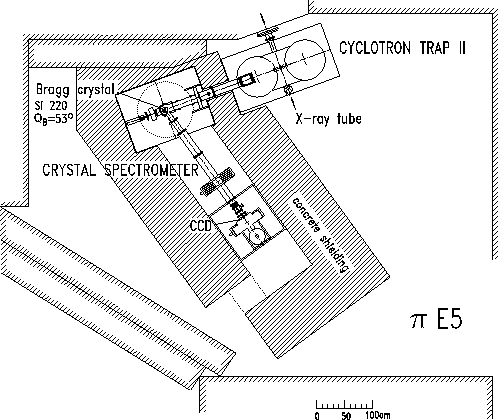The experiment will be set up at the ![]() E5 channel. A sketch of the
set-up is given in Figure 5. The different parts of the experimental set-up
and their role in the experiment will be described below.
E5 channel. A sketch of the
set-up is given in Figure 5. The different parts of the experimental set-up
and their role in the experiment will be described below.

|
|
Figure 5:
Set-up of the experiment at the
|
A proton beam current of 1.5 mA and the full thickness of target E
are required and are taken as basis of our rate estimates. The high beam current
can also be fully exploited as the experiment is not rate limited. The beam
momentum is 110 MeV/c . The cyclotron trap will be tuned to a momentum of accepted
particles of about 82 MeV/c. The particles will be stopped in a thin walled
(Kapton) cylindrical gas target (diameter 60 ![]() , length 200
, length 200 ![]() )
with the cylinder axis coinciding with the axis of the magnetic field. The particle
density of the target gas corresponds to a pressure range from
)
with the cylinder axis coinciding with the axis of the magnetic field. The particle
density of the target gas corresponds to a pressure range from ![]() 1
bar to
1
bar to ![]() 40 bar at room temperature. The required particle densities
can be reached by cooling the target. In order to optimize the stops in the
target gas as compared to the ones in the walls the thickness of the cylinder
wall is restricted to a thickness of
40 bar at room temperature. The required particle densities
can be reached by cooling the target. In order to optimize the stops in the
target gas as compared to the ones in the walls the thickness of the cylinder
wall is restricted to a thickness of ![]() 50
50 ![]() m of Kapton.
The X-ray window at the front plane of the target cylinder will be made out
of 5
m of Kapton.
The X-ray window at the front plane of the target cylinder will be made out
of 5![]() Mylar supported by a stainless steel grid.
Mylar supported by a stainless steel grid.
The magnetic field configuration and the deceleration scheme of the
cyclotron trap has been optimized with tracking calculations. These calculations
predicted a rate of about ![]() pion stops for hydrogen at a
pressure of 1
pion stops for hydrogen at a
pressure of 1 ![]() . In preparation of the present proposal a stop rate
for pions has been determined in deuterium gas at a pressure of
. In preparation of the present proposal a stop rate
for pions has been determined in deuterium gas at a pressure of ![]() measuring the pionic
measuring the pionic
![]() transition (see chapter 3.3 and Figure
6). It can be safely assumed that the pion stop rate is proportional to the
particle density in the pressure region considered and that there is no difference
in stopping power between the two hydrogen iosotopes. The measured number of
about
transition (see chapter 3.3 and Figure
6). It can be safely assumed that the pion stop rate is proportional to the
particle density in the pressure region considered and that there is no difference
in stopping power between the two hydrogen iosotopes. The measured number of
about ![]() stopped pions agrees well with the value given above if
one scales the pressures.
stopped pions agrees well with the value given above if
one scales the pressures.
Muons will be produced by decays of pions orbiting inside the cyclotron
trap. This results in a muon stop rate which is one order of magnitude smaller
than the pion stop rate. This reduction is compensated, however, by a higher
X-ray yields in the ![]() atoms.
atoms.
It is foreseen to shim the so-called form iron of the cyclotron trap in order to increase the injection efficiency by about a factor of two with a corresponding gain in stopping power.